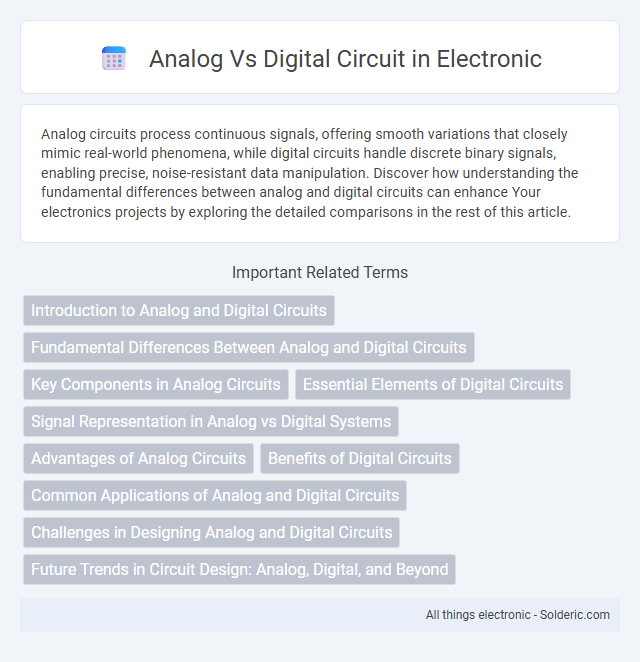Analog circuits process continuous signals, offering smooth variations that closely mimic real-world phenomena, while digital circuits handle discrete binary signals, enabling precise, noise-resistant data manipulation. Discover how understanding the fundamental differences between analog and digital circuits can enhance Your electronics projects by exploring the detailed comparisons in the rest of this article.
Comparison Table
| Feature | Analog Circuit | Digital Circuit |
|---|---|---|
| Signal Type | Continuous signals | Discrete binary signals |
| Noise Sensitivity | High | Low |
| Accuracy | Variable, affected by noise | High, precise |
| Complexity | Simple for basic tasks | Complex, supports advanced operations |
| Power Consumption | Generally low | Higher, depends on design |
| Applications | Audio processing, sensors | Computers, digital systems |
| Data Processing | Real-time continuous data | Discrete data processing |
| Component Examples | Resistors, capacitors, transistors | Microprocessors, logic gates |
Introduction to Analog and Digital Circuits
Analog circuits process continuous signals representing real-world phenomena such as temperature and sound, using components like resistors, capacitors, and transistors to amplify or modify these signals. Digital circuits operate with discrete binary values (0s and 1s), utilizing logic gates and microprocessors to perform complex computations and data storage. The fundamental distinction lies in analog circuits' continuous signal representation versus digital circuits' discrete signal processing, impacting their applications and design methodologies.
Fundamental Differences Between Analog and Digital Circuits
Analog circuits process continuous signals representing physical quantities, enabling smooth variations and detailed information capture. Digital circuits handle discrete binary signals, offering higher noise resistance, easier data manipulation, and compatibility with modern computing systems. Understanding these fundamental differences helps you choose the appropriate circuit type for applications requiring precision or digital data processing.
Key Components in Analog Circuits
Key components in analog circuits include resistors, capacitors, inductors, diodes, and transistors, each playing a vital role in signal processing and amplification. Operational amplifiers (op-amps) are essential for tasks such as filtering, voltage amplification, and oscillation generation. Understanding these components helps you design, analyze, and troubleshoot analog circuits effectively.
Essential Elements of Digital Circuits
Digital circuits rely on essential elements such as logic gates (AND, OR, NOT) that perform binary operations, flip-flops that store data states, and multiplexers that select among inputs based on control signals. These components work together using discrete voltage levels representing binary values (0 and 1) to perform complex computations and data processing. Unlike analog circuits, digital circuits emphasize precise, noise-resistant signal processing through well-defined switching characteristics.
Signal Representation in Analog vs Digital Systems
Analog circuits represent signals as continuous waveforms, capturing an infinite range of values within a defined time period, which enables precise and smooth variations in input and output. Digital circuits encode signals as discrete binary values, typically using voltage levels to represent 0s and 1s, allowing for noise-resistant and easily processed data transmission. The fundamental difference in signal representation directly impacts the accuracy, complexity, and noise tolerance of analog versus digital systems.
Advantages of Analog Circuits
Analog circuits provide superior signal representation for real-world phenomena due to their continuous data processing, offering higher resolution and fidelity in audio and sensor applications. They excel in simplicity and lower power consumption, making them ideal for battery-operated devices and environments where energy efficiency is crucial. Your systems benefit from the inherent smoothness and immediacy of analog signals, which enable precise control and natural sound reproduction without the need for complex conversion processes.
Benefits of Digital Circuits
Digital circuits offer enhanced noise immunity, providing reliable performance even in electrically noisy environments. They enable precise data processing and storage, ensuring high accuracy and consistency in your electronic applications. Scalability and ease of integration with modern microcontrollers and processors make digital circuits ideal for complex and flexible system designs.
Common Applications of Analog and Digital Circuits
Analog circuits are commonly used in audio amplification, radio frequency transmission, and sensor signal processing due to their ability to handle continuous signals. Digital circuits dominate computing, data storage, and digital communication systems, offering precise data manipulation and noise resistance. Many modern devices integrate both analog and digital circuits to leverage the advantages of signal conversion and processing efficiency.
Challenges in Designing Analog and Digital Circuits
Designing analog circuits involves challenges such as managing noise, signal distortions, and precise component matching to maintain signal integrity. Digital circuit design must address issues like timing synchronization, power consumption, and complexity in logic gate integration for reliable operation. Your ability to optimize these factors directly impacts the performance and efficiency of both analog and digital systems.
Future Trends in Circuit Design: Analog, Digital, and Beyond
Future trends in circuit design emphasize the integration of analog and digital domains to leverage the precision of analog signals with the programmability of digital processing, fostering advancements in mixed-signal circuits and system-on-chip (SoC) architectures. Emerging technologies such as neuromorphic computing and quantum circuits promise to transcend traditional analog-digital limitations by mimicking brain-like computation and exploiting quantum phenomena for unprecedented speed and efficiency. Innovations in low-power design, nanotechnology, and AI-driven circuit optimization are driving the evolution toward adaptive, intelligent, and highly efficient electronic systems for applications in IoT, autonomous vehicles, and wearable devices.
analog vs digital circuit Infographic

 solderic.com
solderic.com